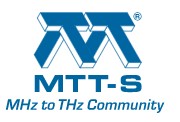Joint RWW/ARFTG Plenary Session
Tuesday, 23 January 2025 10:10 – 12:00
The Final Frontier – Using Si/SiGe Technology in Space Systems
Speaker: John D. Cressler, Georgia Tech, USA
Abstract
Space has been aptly called the “final frontier” (thank you, Star Trek!). The application needs of the global space and aerospace communities are predictably many and varied, ranging from a diverse set of communications and imaging satellites, to the GPS constellation, to microwave and millimeter-wave (mmW) remote sensing to support weather forecasting and climate science, to exploration of other worlds, which include: the mighty James Webb Space Telescope (probing the origins of the universe), the shadowed polar craters of the Moon (where water ice resides), Mars surface (colonization?), and Europa (the search for extraterrestrial life in the water ocean beneath the 10 km ice cap).
While classically, orbital satellites were massive, tough to launch, and extremely expensive (a few $Bs), the current (and rapidly accelerating) trend has swung decidedly towards using relatively low-cost (a few $M) and easy to launch constellations of single or multi-U CubeSats (1U = 10x10x10 cm3) to cost-effectively address the plethora of emerging needs. These days, this has been increasingly supported by commercial space ventures (e.g., SpaceX, BlueOrigin et al., vs. the old gang—NASA and DoD), which are proliferating rapidly.
As I have long argued [1], Si/SiGe HBT BiCMOS technology provides a unique solution for many of the needs of these emerging space systems, including: 1) extreme levels of performance (multi-hundred GHz) with the SiGe HBT and high integration levels with on-board CMOS, for realizing compelling system functionality/unit volume, at low cost; 2) the rapid improvement of all electronic circuit relevant performance metrics with cooling, with operational capability down into the mK quantum regime (SiGe HBTs love chilly weather!); 3) the ability to operate robustly up to 150-200°C, with modest performance loss; 4) the ability to operate robustly over wide temperature ranges (in principle from mK to 150-200°C); 5) built-in robustness to multi-Mrad total ionizing dose radiation; and 6) built-in heavy ion induced latchup immunity (read: those pesky GeV cosmic rays).
Long ago (1990s), the notion of creating a low-cost Si-based electronic + photonic integrated circuit (EPIC) “superchip” was envisioned (R. Soref), which brought together advanced SiGe HBTs (analog, RF-mmW), CMOS (digital), and Si integrated photonics (with the possible exception of a laser, which could be flipped onto the die worse case). In essence, EPICs are a low-cost, high-yielding, reliable, highly integrated Si platform for putting electrons and light into the same conversation! Clearly this represents a paradigm shift to business as usual. Now, with even more compelling system functionality/unit volume, at low cost. Such an EPIC superchip could in principle satisfy all-comers-of-new-needs. While photonics has long been used in space (think solar cells, imagers), EPICs are new to that space game, but possess great potential for the emergent needs in this new vision of CubeSat/SmallSat driven space systems, including, thing like: LIDAR (spacecraft-to-spacecraft positioning); deep space and within- constellation optical communications (huge data rate improvement); and on-spacecraft high bandwidth data transport (think data center in the sky for instruments that spew out tons of data that need to get back home quickly). This field of EPICs in space is only a few years old, but already much has been learned, and results look very encouraging.
In this plenary address, I will highlight the current status and the future trends of using Si/SiGe electronic and photonics in space systems.
Bio
John D. Cressler received his PhD from Columbia University in 1990. He is currently Regents Professor, Schlumberger Chair Professor in Electronics, and the Ken Byers Teaching Fellow in Science and Religion, in the School of Electrical and Computer Engineering at Georgia Tech. His research interests center on SiGe electronic and photonic devices, circuits, and systems. He and his team have published over 800 scientific papers in these areas, and he has graduated 72 PhD students over his 32-year academic career. He has published a number of books, both non-fiction and historical fiction, and he has received a number of awards for both his teaching and research.
From niche to dominance – Si/SiGe in integrated microwave electronics
Speaker: Hermann Schumacher, Ulm University, Germany
Abstract
Si/SiGe frontend ICs played a crucial role in making wireless systems in the upper microwave and millimeter-wave range a common sight in civilian, even consumer, systems, such as active satellite antennas for low-earth orbit satellite systems, automotive radars, or high-speed communication links in 5G and emerging 6G standards.
Getting there has not been easy. Silicon, after all, has a rather mediocre electron mobility compared to III-V semiconductor families, and a truly semi-insulating substrate suitable for planar transmission line passives is hard to achieve. Starting as early as 1965 (T.M. Hyltin), Silicon was investigated as a potential competitor for GaAs as a semiconductor substrate for microwaves. Early in the 1980s, advances in the technology of Si IMPATT devices breathed new life into microwave electronics on Si. But by and large, monolithic microwave integrated circuits (MMICs) remained firmly in the GaAs camp.
Starting in the late 1990s, this changed when the Si microwave IC community realized that the path forward was not to be found in imitating GaAs design approaches. The problem with lossy Si substrates was mitigated by thin-film microstrip lines. With the Si/SiGe heterojunction bipolar transistor an active device emerged which rivaled, and later surpassed, III-V high electron mobility transistors in transit frequency and maximum frequency of oscillation.
The advantage of using Silicon for micro- and millimeter-wave ICs is, at least initially, not in its lower substrate cost. Given the comparatively small technological changes introduced by Si/SiGe HBTs to existing and mature BiCMOS processes, Si-based MMICs very quickly increased in complexity. Once commercial markets evolved, the ability to fabricate Si-MMICs on large wafer diameters rapidly brought cost down.
The underlying Si processes offered mixed-signal and digital add-ons unavailable in III-V competitors, reducing the packaging complexity. Concentrated passives, including on-chip transformers, replaced transmission line elements, leading to very substantial area reduction. Even micro-electro-mechanical switches (MEMS) can be integrated on chip, including the necessary DC-DC converters for electrostatic actuation. While at RF, MEMS did not catch on as initially expected, their time may still come as we move further up in frequency.
The IEEE Topical Meetings on Silicon Monolithic Integrated Circuits in RF Systems (SiRF), whose 25th installment we celebrate in 2025, have been an excellent yardstick of this field’s progress over the years, while still providing room for other device concepts, such as SiGe MODFETs, graphene MODFETs, or carbon nanotube transistors.
Results from SiRF’s proceedings will be used to outline a short history of Si-based micro- and millimeter-wave electronics, augmented with earlier results which may help to understand where we came from, and why Si/SiGe BiCMOS was such a disruptive change. The presentation will conclude with a look ahead, continuously aware that “predictions are very hard, especially about the future”, an aphorism attributed to Yogi Berra, Albert Einstein, but uttered by neither.
Bio
Hermann Schumacher received is Diploma in Electrical Engineering in 1982, and his Doctorate in Engineering (Dr.-Ing., with highest distinction) in 1986, both from RWTH Aachen University. In 1986, he joined Bell Communications Research in Red Bank, NJ, USA, researching compound semiconductor devices for optoelectronic integration of high-speed fiberoptic applications. Among other things, he was involved in early work on InP/InGaAs heterojunction bipolar transistors (HBTs).
In 1990, he joined Ulm University, Ulm, Germany. There, he and his research group worked on Si/SiGe HBTs (initially with the Daimler Research Center in Ulm), and, increasingly, microwave and millimeter-wave integrated circuits. From 2000 until 2016, he led the Competence Center on Integrated Circuits in Communications, a public-private partnership. Investigated applications ranged from short-range ultra-wideband radars for vital sign detection and security systems to complex frontend ICs for active electronically scanned satellite antennas.
From 2011 until 2022, Professor Schumacher developed and directed the School of Advanced Professional Studies, the continuing education unit of Ulm University.






